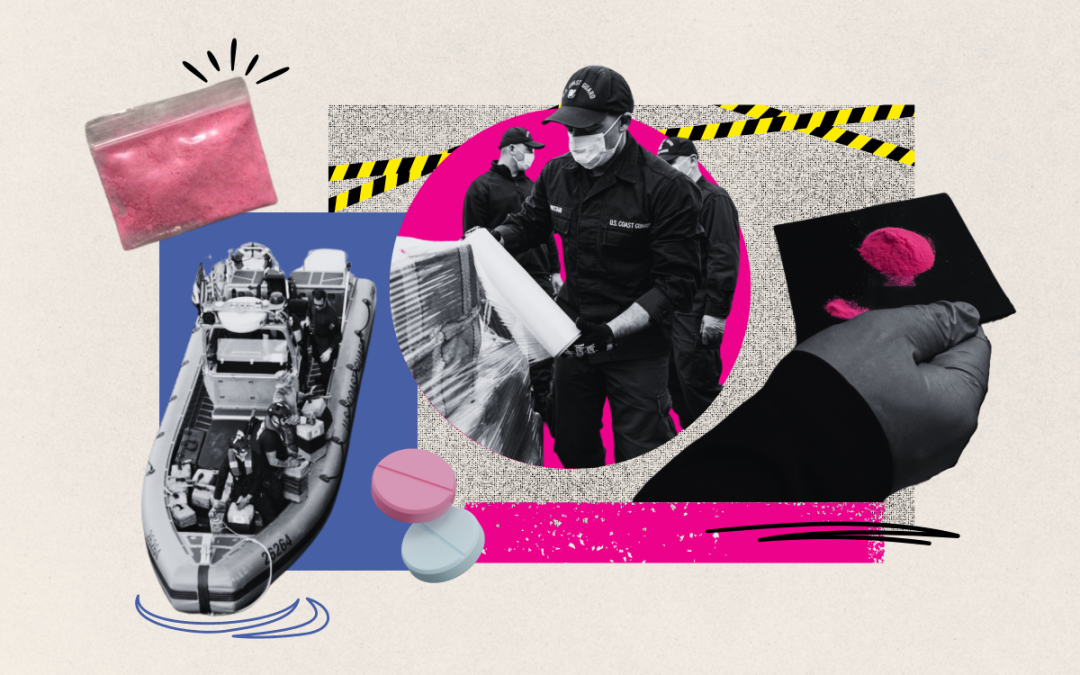The following article was sourced from Newsweek.
Pink is the new white – at least in the international, dynamic domain of synthetic drugs.
A potent powder known among users and traffickers as “pink cocaine” is gaining traction in the United States, including in New York and California, where authorities seized more than 140 pounds of the high-powered hallucinogenic during a four-month patrol off the coasts Central and South America ending in early June, U.S. Coast Guard officials said.
The drug, also known as “tusi” on streets throughout Latin America and parts of Europe, varies greatly in composition – often differing down to the individual batch, law enforcement officials and substance abuse experts told Newsweek.
The illicit concoction, which sells for as little as $10 per gram, doesn’t typically contain cocaine, despite its nickname. Instead, the powder tinted with food coloring widely comprises ketamine, along with smaller amounts of MDMA, methamphetamine or opioids.
“Certainly, any customer would assume that there would be cocaine in something marketed as ‘pink cocaine,'” New York City Special Narcotics Prosecutor Bridget Brennan said Wednesday. “But it’s interesting how rarely we actually find it.”
Brennan’s office first encountered the ketamine-based party drug in January 2023, as authorities arrested Carlos Asturias, 51, while driving a Toyota Highlander in Manhattan with 10 pounds of so-called “pink cocaine” allegedly stashed in a backpack. But subsequent laboratory tests revealed the peculiar powder to be pure ketamine – a dissociative sedative with mild hallucinogenic effects.
“The primary concern is for the users,” Brennan told Newsweek. “Cocaine is a stimulant, and someone who is expecting to get cocaine may know how it affects their body or their tolerance. Ketamine is something completely different. It’s an anesthetic, a sedative and it has hallucinogenic properties as well.”
Abuse of ketamine, a popular club drug available widely in powder or liquid forms, can cause unconsciousness or dangerously labored breathing.
“So, it has a very different effect on the body,” Brennan said, in stark contrast to cocaine, an intense stimulant that can produce euphoria within mere seconds. “It really could be harmful to the user, and the users don’t know what they’re getting.”
The widely varying composition of so-called “pink cocaine” makes it virtually impossible for users to be aware of the life-threatening risks they may face, she said.
“The person who thinks they’re getting cocaine and ends up getting a pretty strong dose of ketamine may be completely knocked out,” Brennan said. “The effect on them is not going to be what they would’ve expected, and they may not be prepared in any way shape or form for that kind of reaction. It’s dangerous.”
At least seven investigations by Brennan’s office to date have involved “pink cocaine,” she said.
Pink is the new white – at least in the international, dynamic domain of synthetic drugs.
A potent powder known among users and traffickers as “pink cocaine” is gaining traction in the United States, including in New York and California, where authorities seized more than 140 pounds of the high-powered hallucinogenic during a four-month patrol off the coasts Central and South America ending in early June, U.S. Coast Guard officials said.
The drug, also known as “tusi” on streets throughout Latin America and parts of Europe, varies greatly in composition – often differing down to the individual batch, law enforcement officials and substance abuse experts told Newsweek.
The illicit concoction, which sells for as little as $10 per gram, doesn’t typically contain cocaine, despite its nickname. Instead, the powder tinted with food coloring widely comprises ketamine, along with smaller amounts of MDMA, methamphetamine or opioids.

“Certainly, any customer would assume that there would be cocaine in something marketed as ‘pink cocaine,'” New York City Special Narcotics Prosecutor Bridget Brennan said Wednesday. “But it’s interesting how rarely we actually find it.”
Brennan’s office first encountered the ketamine-based party drug in January 2023, as authorities arrested Carlos Asturias, 51, while driving a Toyota Highlander in Manhattan with 10 pounds of so-called “pink cocaine” allegedly stashed in a backpack. But subsequent laboratory tests revealed the peculiar powder to be pure ketamine – a dissociative sedative with mild hallucinogenic effects.
“The primary concern is for the users,” Brennan told Newsweek. “Cocaine is a stimulant, and someone who is expecting to get cocaine may know how it affects their body or their tolerance. Ketamine is something completely different. It’s an anesthetic, a sedative and it has hallucinogenic properties as well.”
Abuse of ketamine, a popular club drug available widely in powder or liquid forms, can cause unconsciousness or dangerously labored breathing.
“So, it has a very different effect on the body,” Brennan said, in stark contrast to cocaine, an intense stimulant that can produce euphoria within mere seconds. “It really could be harmful to the user, and the users don’t know what they’re getting.”
The widely varying composition of so-called “pink cocaine” makes it virtually impossible for users to be aware of the life-threatening risks they may face, she said.
“The person who thinks they’re getting cocaine and ends up getting a pretty strong dose of ketamine may be completely knocked out,” Brennan said. “The effect on them is not going to be what they would’ve expected, and they may not be prepared in any way shape or form for that kind of reaction. It’s dangerous.”

At least seven investigations by Brennan’s office to date have involved “pink cocaine,” she said.
Big seizure
Nearly 3,000 miles away from Manhattan, crew members aboard U.S. Coast Guard Cutter Munro returned last month to their home port in Alameda, California, after seizing nearly 35,000 pounds of cocaine and more than 140 pounds of “tusi” during deployments in the Eastern Pacific.
Authorities estimate the narcotics recovered during 11 vessel interdictions off the coasts of Mexico, Central and South America in February and March had an estimated wholesale value of $500 million – or up to $2 billion once peddled on streets. Five suspects now face charges in California in connection to the patrol, federal prosecutors told Newsweek.
Rear Admiral Andrew Sugimoto, commander of the Coast Guard’s 11th district, praised Munro’s crew for “disrupting organized crime” during its multi-mission deployment.
“The effort put in while interdicting more than 33,000 pounds of cocaine in a few weeks’ time is unparalleled,” Sugimoto said in a statement as the massive haul was offloaded in San Diego on May 28. “We will continue our commitment to stopping these criminals and the vast amounts of drugs they attempt to bring into our country.”
Joseph Palamar, an associate professor and drug researcher at NYU Langone Health, published a study last year detailing the “new ketamine concoction” confounding both users and authorities.
The pink powder, sometimes referenced as “tuci” or “cocaina rosada,” is a phonetic translation of “2C” – a series of synthetic hallucinogens primarily favored by hard-partying clubgoers, Palamar told Newsweek.
“Those are psychedelic phenethylamines which go back to the 1970s,” he said. “Those have been popular underground drugs for decades, particularly 2C-B.”
Drug abusers in search of new highs started turning to the mysterious mashup throughout Latin America in recent years. The compound has also been detected throughout the United Kingdom, Switzerland, Australia and Canada, according to Palamar’s May 2023 study.
“The play on words right there is clever or deceptive, depending on how you want to look at it,” Palamar continued. “They’re kind of tricking people. Now people for the most part don’t even know what’s in ‘tusi’ … I don’t think any two concoctions are going to be identical.”
The burgeoning yet largely unknown drug may get an unwanted bump in popularity thanks to its alleged link to Sean “Puffy” Combs, who has been accused of sexual assault by a former employee. Rodney “Lil Rod” Jones, a former producer and videographer, alleges the mogul sexually assaulted him while working for Combs from fall 2022 through November 2023.
The 98-page amended filing, which seeks $30 million in damages, alleges Combs regularly abused the pink-hued drug. It alleges employees were mandated to carry black Prada pouches with drugs including “tuci,” court documents show. The lawsuit also alleges Combs’ girlfriend at the time transported an unknown quantity of “tuci” in April 2023 via private jet from south Florida to a music festival in Virginia.
Messages seeking comment from attorneys representing Combs were not immediately returned on Thursday.
The Drug Enforcement Administration, meanwhile, considers “tusi” as a rising concern, particularly as the Sinaloa Cartel continues capitalizing on the trend.
“The Mexican government has not disclosed the seizure of any tusi labs in Mexico, but the Sinaloa Cartel is capable of importing large quantities of ketamine from China to facilitate tusi production in Mexico,” according to the federal agency’s 2024 national drug threat assessment.
Tiffany Hairston, a longtime substance abuse counselor in Toledo, Ohio, said she’s yet to encounter the drug while working with clients, but doesn’t expect to stay insulated from the colorful compound for long.
“It’s pretty, and it looks fancy,” Hairston told Newsweek. “Drugs tend to go either West Coast, East Coast and then middle – or East Coast, West Coast and then middle. We’re usually on the late train to get lot of things.”


Recent Comments